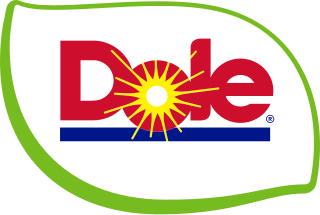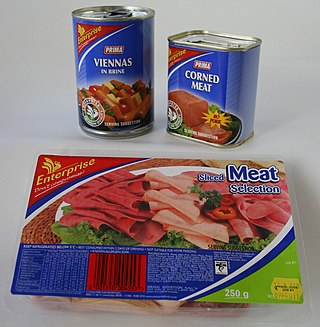
Listeria monocytogenes is the species of pathogenic bacteria that causes the infection listeriosis. It is a facultative anaerobic bacterium, capable of surviving in the presence or absence of oxygen. It can grow and reproduce inside the host's cells and is one of the most virulent foodborne pathogens: 20 to 30% of foodborne listeriosis infections in high-risk individuals may be fatal. In the European Union, listeriosis follows an upward trend that began in 2008, causing 2,161 confirmed cases and 210 reported deaths in 2014, 16% more than in 2013. Listeriosis mortality rates are also higher in the EU than for other foodborne pathogens. Responsible for an estimated 1,600 illnesses and 260 deaths in the United States annually, listeriosis ranks third in total number of deaths among foodborne bacterial pathogens, with fatality rates exceeding even Salmonella spp. and Clostridium botulinum.

Dole plc is an Irish-American agricultural multinational corporation headquartered in Dublin, Ireland. The company is among the world's largest producers of fruit and vegetables, operating with 38,500 full-time and seasonal employees who supply some 300 products in 75 countries. Dole reported 2021 revenues of $6.5 billion.

Listeria is a genus of bacteria that acts as an intracellular parasite in mammals. Until 1992, 10 species were known, each containing two subspecies. By 2020, 21 species had been identified. The genus is named in honour of the British pioneer of sterile surgery Joseph Lister. Listeria species are Gram-positive, rod-shaped, and facultatively anaerobic, and do not produce endospores. The major human pathogen in the genus Listeria is L. monocytogenes. It is usually the causative agent of the relatively rare bacterial disease listeriosis, an infection caused by eating food contaminated with the bacteria. Listeriosis can cause serious illness in pregnant women, newborns, adults with weakened immune systems and the elderly, and may cause gastroenteritis in others who have been severely infected.

Listeriosis is a bacterial infection most commonly caused by Listeria monocytogenes, although L. ivanovii and L. grayi have been reported in certain cases. Listeriosis can cause severe illness, including severe sepsis, meningitis, or encephalitis, sometimes resulting in lifelong harm and even death. Those at risk of severe illness are the elderly, fetuses, newborns and those who are immunocompromised. In pregnant women it may cause stillbirth or spontaneous abortion, and preterm birth is common. Listeriosis may cause mild, self-limiting gastroenteritis and fever in anyone.

Maple Leaf Foods Inc. is a Canadian multinational consumer-packaged meats and food production company. Its head office is in Mississauga, Ontario.

The 2008 Canadian listeriosis outbreak was a widespread outbreak of listeriosis in Canada linked to cold cuts from a Maple Leaf Foods plant in Toronto, Ontario. There were 57 total confirmed cases, resulting in 23 deaths.

Tiger Brands Limited is a South African packaged goods company. In addition to the company's South African operations, Tiger Brands has direct and indirect interests in international food businesses in Chile, Zimbabwe, Mozambique, Nigeria, Kenya, Lesotho and Cameroon. Tiger Brands is South Africa's largest food company.
The concept of a minimal infective dose (MID), also known as the infectious dose, has traditionally been used for infectious bacteria that contaminate foods. MID was defined as the number of bacteria ingested from which a pathology is observed in the consumer. Examples such as this are found in textbooks: to cause gastrointestinal disorders, the food must contain more than 100,000 Salmonella per gram. However, in such a formulation, an inaccuracy immediately becomes apparent: to know the dose ingested, concentration is not enough. It is also necessary to know the mass of the portion:

The 2011 United States listeriosis outbreak was a widespread outbreak of Listeria monocytogenes food poisoning across 28 US states that resulted from contaminated cantaloupes linked to Jensen Farms of Holly, Colorado. As of the final report on August 27, 2012, there were 33 deaths and 147 total confirmed cases since the beginning of the first recorded case on July 31, 2011. It was the worst foodborne illness outbreak in the United States, measured by the number of deaths, since the Centers for Disease Control and Prevention began tracking outbreaks in the 1970s, or tied with the worst, an outbreak of listeria from cheese in 1985, depending on which CDC report is used.
Listeria virus P100 is a virus of the family Herelleviridae, genus Pecentumvirus.
The Australian Food Safety Information Council is a health promotion charity The Council develops consumer-targeted food safety information to address the number of Australians getting sick from food poisoning by providing simple, easy to follow consumer information on the handling, storage and preparation of food. A study by Food Standards Australia New Zealand and the Australian National University in 2022 estimated there are 4.67 million cases of food poisoning in Australia each year that result in 47,900 hospitalisations, 38 deaths and a cost to the economy of $2.1 billion.

The 2014 Macedonia listeriosis outbreak was an outbreak caused by Listeria food poisoning.
Food safety in Australia concerns the production, distribution, preparation, and storage of food in Australia to prevent foodborne illness, also known as food safety. Food Standards Australia New Zealand is responsible for developing food standards for Australia and New Zealand.

The 2017–2018 South African listeriosis outbreak was a widespread outbreak of Listeria monocytogenes food poisoning that resulted from contaminated processed meats produced by Enterprise Foods, a subsidiary of Tiger Brands, in Polokwane. There were 1,060 confirmed cases of listeriosis during the outbreak, and about 216 deaths. It is the world's worst ever listeriosis outbreak.

Food safety in the United States relates to the processing, packaging, and storage of food in a way that prevents food-borne illness within the United States. The beginning of regulation on food safety in the United States started in the early 1900s, when several outbreaks sparked the need for litigation managing food in the food industry. Over the next few decades, the United States created several government agencies in an effort to better understand contaminants in food and to regulate these impurities. Many laws regarding food safety in the United States have been created and amended since the beginning of the 1900s. Food makers and their products are inspected and regulated by the Food and Drug Administration and the Department of Agriculture.

Milk borne diseases are any diseases caused by consumption of milk or dairy products infected or contaminated by pathogens. Milk borne diseases are one of the recurrent foodborne illnesses—between 1993 and 2012 over 120 outbreaks related to raw milk were recorded in the US with approximately 1,900 illnesses and 140 hospitalisations. With rich nutrients essential for growth and development such as proteins, lipids, carbohydrates, and vitamins in milk, pathogenic microorganisms are well nourished and are capable of rapid cell division and extensive population growth in this favourable environment. Common pathogens include bacteria, viruses, fungi, and parasites and among them, bacterial infection is the leading cause of milk borne diseases.
The 2008–2009 Chilelisteriosis outbreak was an epidemic outbreak of listeriosis in that country, caused by the species Listeria monocytogenes, which spread mainly through foods of animal origin, such as cecina, sausages, cheese and other dairy products. As of August 2009, 164 cases had been recorded, with a total of 16 deaths, among whom different strains of the bacterium were detected.










